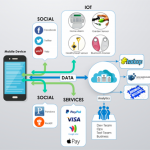 Gal Tunik explains the necessity of test automation in mobile applications, citing the unique challenges that that platform raises, including the intricate differences between mobile and desktop interfaces, and performance test results for applications as well as mobile networks.
Gal Tunik explains the necessity of test automation in mobile applications, citing the unique challenges that that platform raises, including the intricate differences between mobile and desktop interfaces, and performance test results for applications as well as mobile networks.
It is no surprise in this day and age of instant-on gratification that mobile devices are gaining momentum. People have become accustomed to accessing information when they want it, wherever they are, and the mobile device is one way to stay connected. Across all industries, companies are realizing that to remain competitive, they must provide customers with ways to make everyday connectivity to the world easier. However, in order to create a successful mobile application, it is important that companies conduct the necessary tests to ensure that it is market-ready.
Accelerating this momentum is the hype surrounding such new technologies as the superfast 4G network, bar codes, Near Field Communication (NFC) and augmented reality. These all provide companies with attractive business opportunities and spur innovation. More and more, companies are increasing efforts and adding resources to develop mobile applications. Twenty-four percent of executives in charge of their companies’ mobile strategies reported that they would more than double their spending in the upcoming year, according to a recent independent Forrester Research survey1 of mobile executives. Additionally, 46 percent stated they would increase their budgets.
Mobile applications have revolutionized how people conduct business. For example, using a smartphone, a retail store manager can check the exact time product inventory is due in her store. Nurses can quickly access patients’ health records from the examining room and sales representatives are able to multi-task and report on deal statuses while on their way to the airport.
However, as with any emerging technology, a number of unique challenges can arise when developing and implementing mobile applications. Mobile applications don’t simply imitate the desktop environment—they have their own user interface (UI) requirements, business process flows, and infrastructure dependencies.
In addition, there are a growing number of mobile devices— smartphones, PDAs, tablets, and specialized devices such as a delivery clerk’s scanning and tracking handheld. In recent years, there have also been a number of different mobile operating systems. To add even more complexity, there is a choice of implementation options—such as thick vs. thin client. All of this increases the strain on IT to build, port and
maintain mobile applications. It also heightens the risk of quality and performance problems.
Functional Validation
One way to curtail glitches is to make certain mobile applications go through functional validation. This requires testing applications for mobile devices, similar to how desktop-based applications are tested, to ensure usability. Functional validation is based on the concepts of collaboration, test asset management, reusability, accurate reporting and analysis. Similar to the desktop application world, the bulk of testing on mobile devices is currently done manually.
There are some who are skeptical about the accuracy of manual testing. Can a test engineer simply drive to a remote location and log into the credit union’s website to check his account balance? Or, can he see whether he still gets a good network connection while delivering a package to a far-away golf course? The problem with manually testing mobile applications is the lack of coverage and scalability, as well as the associated costs, especially if an application needs to be re-tested multiple times to ensure development and quality. While a test engineer can manually key in a handful of transactions, he cannot continuously test and monitor the connection for application availability or test for all possible scenario permutations. Additionally, a tester is not able to quickly identify problems, fix them, and re-run all the tests required to validate the fix.
Another popular debate is whether testing should be done on an application’s physical device versus using emulators. However, the question should really be: how should we test both native applications and mobile web applications to achieve the required quality?
Many industry experts argue that using handsets for testing, as opposed to testing the application on a normal browser or emulator, requires an overhead of logistics. However, in order to ensure that they function and perform properly, it is imperative that applications be tested on mobile handsets. There are several reasons for this, ranging from the theoretical to the practical:
· For one, usability testing on emulators and browsers with any extensions do not represent what will be seen on the actual device. With Android specifically, emulated “vanilla” environments almost never represent the actual behavior of the phone, as vendors tend to modify the “source code” of the handset and add their own customization layers.
- Environment-related testing is critical as mobile applications rely on the location, accelerometer and network. Simply put, the test cannot be done in a simulated environment.
- Another factor is interoperability. A mobile handset “lives” in a communication environment and behaves accordingly. For example, an incoming phone call always receives priority over any application that is in use. Testing scenarios that see what happens to an application when a phone call is received is critical, as this is an everyday occurrence.
- As many mobile users travel internationally, the proper network-related testing must be conducted. For instance, an application developed for Vodafone in the UK does not necessarily work on the Verizon network in the US. Network neutrality has not been integrated in the cellular world, which means traffic manipulation and modification is still very common in the cellular environment.
- A common concern amongst mobile users is security. People are sensitive to data such as bank account numbers that remain on handsets, or passwords that are displayed on the screen. Testing for these types of security concerns in a simulated environment is not a good use of time, because what is required to be tested is the behavior of the actual handset. Adding to the challenge, not all handsets have the same security designs, so each device must be individually tested.
Performance Validation
A second aspect of the proliferation of mobile applications is the need for performance validation. Applications must be validated to ensure performance expectations are met. The user expectations from these applications may even be higher than those of their desktop counter-parts. Performance validation for mobile applications is crucial and, at times, more complex than that of desktop applications.
Mobile applications, by their very nature, answer a desire as well as a need for access to information “24/7”. Quite often they are built to provide access to a critical subset of desktop applications. These micro-business processes must always be readily available, to ensure businesses continue to function even when no one is in the office.
Another important performance factor is that mobile applications are affected by mobile network conditions, such as bandwidth limitations, which are more pronounced than those of land-line networks. These restrictions may adversely affect the communication between a handset and the back-end servers. Automating performance validation is needed to reach the large number of simulated users that will be accessing the tested application at any given moment. This can be achieved through simulated users running on emulators and browsers. Without this kind of automation, it is virtually impossible to create a realistic load on the application servers and infrastructure.
When replicating the appropriate network conditions, it must be ensured that a simulated mobile user is experiencing the same bandwidth throttling and network delays that a real mobile user would. In order to complete the test, real handsets executing the relevant business processes should be running parallel to the automated performance test. This allows the end user experience to be measured, while also testing the behavior of the application’s servers and infrastructure under load.
To appropriately test mobile applications, it is best to bring together a large number of browsers and emulator-based virtual users, simulations of mobile network conditions, as well as actual handsets to test business processes. This not only ensures performance validation, but provides comprehensive and accurate end-to-end results for mobile applications.
Conclusion
Automated functional and performance testing has a proven track-record in desktop-based applications. It helps companies deploy higher-quality software applications, reduce business risk, and accelerate problem-to-resolution. This ultimately helps organizations avoid costly interruptions and errors. The growing demand for instant information, especially through mobile applications, should encourage organizations to adopt automated testing strategies and solutions that are designed specifically for their mobile application needs.
1. Forrester Research, Inc. “2011 Mobile Trends,” January 24, 2011


















